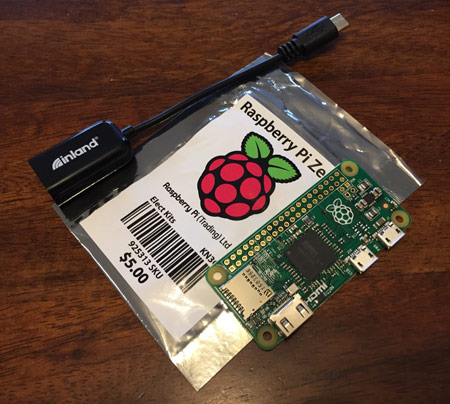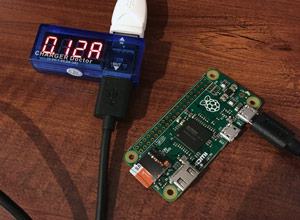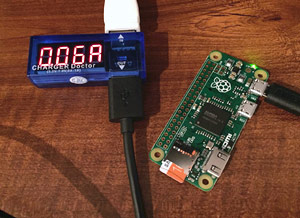tl;dr: The Raspberry Pi Zero uses about the same amount of power as the A+, and at least 50% less power than any other Pi (B+, 2 B, 3 B).
On November 26, the Raspberry Pi foundation announced the Raspberry Pi Zero, a $5 USD computer that shares the same architecture as the original Raspberry Pi and A+/B+ models, with a slightly faster processor clock (1 Ghz), 512 MB of RAM, and sans many of the essential ports and connectors required for using the Pi as an out-of-the-box computer.

The Raspberry Pi Zero - quite a small Linux computer!
If you're considering buying on Pi Zero and using it as a 'lite' desktop computer, you might want to rethink your strategy; the Pi model 2 B has four full-size USB 2.0 ports, a LAN port, full-size HDMI, audio/video out, and more. This little Zero just has one micro USB port and mini HDMI port (both require adapters for most uses), no network port, no camera (the latest Zero revision includes a mini camera connector!) or display connectors, and if you want a header for GPIO use, you have to solder one on yourself!
But this board is pretty awesome for some use cases, like embedded computing (think popping one into a halloween costume, or using a few in a robotics project), or experimentation where you don't want to worry about accidentally blowing up an expensive computer/control device (figuratively or literally!).
One of the most important questions, then, is how much power does the Pi Zero consume? If you want to use it in an embedded application, you need to make sure it's using as little power as possible.
|
|
|
In the past, for the Pi Dramble project, I've measured power consumption for all the other Pi models I own (A+, B+, and model 2), so I thought I'd use my PowerJive USB Power Meter to measure the usage for the Zero for comparison:
| Pi Model | Pi State | Power Consumption |
|---|---|---|
| A+ | Idle, HDMI disabled, LED disabled | 80 mA (0.4W) |
| A+ | Idle, HDMI disabled, LED disabled, USB WiFi adapter | 160 mA (0.8W) |
| B+ | Idle, HDMI disabled, LED disabled | 180 mA (0.9W) |
| B+ | Idle, HDMI disabled, LED disabled, USB WiFi adapter | 220 mA (1.1W) |
| model 2 B | Idle, HDMI disabled, LED disabled | 200 mA (1.0W) |
| model 2 B | Idle, HDMI disabled, LED disabled, USB WiFi adapter | 240 mA (1.2W) |
| Zero | Idle, HDMI disabled, LED disabled | 80 mA (0.4W) |
| Zero | Idle, HDMI disabled, LED disabled, USB WiFi adapter | 120 mA (0.7W) |
As you can see in the table above, the Zero uses a similar amount of power as the long-time power-sipping champ, the A+—both use less than half the power of any other more fully-equipped Pi. This is no doubt due to the lack of extra ports and circuits that are active on the Pi itself. This means that a small battery pack (say, a flat Li-Ion pack rated at 1,400 mAh) should last well over 4 hours, even if you have moderate activity while using a cheap USB WiFi dongle!
If you don't need WiFi or some other network adapter, disable the ACT/PWR LED, follow these other Pi energy-saving tips, and use a 2,000+ mAh battery pack (like one of the cheap ones you can get for phone charging), you can probably eke out a day's worth of Pi Zero usage, or more.
This isn't quite as good as you can get with an Arduino (sipping energy at 10-30 mA, or less if you optimize for power savings), but I'm a lot more likely to run Pi Zeros 24x7 for monitoring projects (as long as their networking needs are limited) than any other Pi model.
See related:


Comments
Looking at the official Raspberry Pi page for the zero, I see it listed as having a "A mini-HDMI socket for 1080p60 video output".
So you might want to fix the "no [...] display connectors" line. It's misleading.
Good article overall, though -- I made a board with an ATtiny85 which drew six *micro* amps in sleep mode!
Thanks for the note—I've fixed that line, and also fixed a typo (
s/on/one) too.I was working on tweaking my Uno to go into a low-power sleep mode between readings every few seconds on one project (I could get down to < 1 mA between readings), but it was throwing off my code, since it required communication with a clock-based service, and sleep with the Uno wasn't reliable for timing :(
Via hackernews. Could you check how current changes if you turn off the HDMI circuits via:
/usr/bin/tvservice -o
According to this source they heard this saves 28 mA (hearsay) but I think that generation of rpi might have a dedicated chip (for HDMI or composite) whereas in the zero HDMI driven directly. I would appreciate if you checked whether this makes any difference! Thanks.
I just checked, and it does indeed save ~30 mA. I'm going to do some more testing, and will update the post with more details.
Your work is most appreciated. My initial question when told about the new Pi was what had been been to its power consumption. A simple 5 cell power bank (easily built from old 18650 laptop batteries and a 3$ DIY case) could then power a data logger for a full weekend. Pretty amazing considering its flexibility and power.
What are you using to measure the power? (That blue gadget)
It's called a 'USB Charger Doctor' and I bought mine from Amazon.com. It's a little flakey, so I'd recommend one of the other USB power monitors that has a higher rating (I'm probably going to be buying a nicer one soon).
Thank you for the power comparison. Would you know if the zero is able to back power up? My B is able to run off my monitor's usb hub power and wakes us the hub through a leakage path. My model 2B can't do that. I would be great to not need a wall wart.
Thanks, I've been wanting to know that!
Another question I haven't seen answered yet: how much does it weigh? I'm interested in both figures because we fly the Raspberry Pi on high altitude balloons.
Much has been written about idle loads of Pi's of all kinds, but how about checking power consumption at full load?
E.g.:
- CPU only
- WLAN only
- GPU only
- all together
Best regards,
1. How can a simple device have such a large current draw? My Note 2 phone has a ~3000 mAh batt and lasts about 12 -14 hrs (i.e. avg current draw of 250mA) with various usage throughout the day, with Wifi and cellular running in the background and screen turning on various times, lots of apps running, lots of sync, sensors, etc etc. And here we have a tiny board, doing nothing much drawing 300mA - 400mA in idle!! Where is the power going?
2. Will be good if you remove references to Charger Doctor since it gave you incorrect results. E.g. on this page, you say "so I thought I'd use my USB 'Charger Doctor' to measure the usage for the Zero for comparison"... and this is confusing since I understand the power numbers have been updated with Jive.
3. Also, may I request you to create a single page, continuously updated with latest power numbers. Right now you have two posts here and there's a page here: http://www.pidramble.com/wiki/benchmarks/power-consumption
Thanks for pointing that out—the pidramble.com page should be the canonical source. I update those Wiki pages whenever I work on the Dramble and Pi-related projects. I've also updated my post here to reflect all the latest test results.
You may want to make a revision, the Pi Zero now also includes a camera connection.
Good catch! I updated the post.
Another reader has suggested the use of
powertop --auto-tuneto further reduce power consumption (and used 44 mV/hour), specifically using a lower-power configuration found in this Solar Powered Weather Station repo (some really awesome hardware/setup details in there!).I'm going to try to do some further testing once I am able (right now the Pi Zeros are all in a large jumble of other electronic bits and bobs as things have been a bit hectic!).
Jeff, any idea what the draw would be, using OTG as the power AND network connection on a Pi Zero? All other power-saving settings above would be applied.
I am trying to see how many in total I can run from all the rails in an ATX psu in a beowulf cluster. I am well aware of the 480m/s limit on the usb, plus the 128 node usb limit; I'm working around that part.
Aside from the USB limits, I just want to guestimate for ANY psu, given the load the PSU can handle.
Can you add the Edison device to this comparison. It appears to be close to or less than the zero with some other advantages (wifi integration/significantly more computation speed)
Which Edison model are you thinking of? The only ones I've seen start at 7x the price of the Zero and don't have nearly the hardware capabilities of the Pi. There are of course other advantages, but they're really an entirely different class of computing devices.
Please update with the new slew of Pi's... mainly the Pi Zero W. Thanks
I'm sorry for commenting on a 4 year old post but could a solar charger be used to power the pi zero?
Yes, but it would need some sort of battery to assist and even out the flow, because solar energy fluctuates quite a bit.
How can I keep powered RPi zero w 24/7 for live video streaming
Take a look at this guide for some ideas for getting started. It could be difficult to make sure it's running 24x7, depending on your climate, unless you can run power to the Pi from mains.
> This isn't quite as good as you can get with an Arduino (sipping energy at 10-30 mA, or less if you optimize for power savings).
A lot less, actually. I've personally driven a custom-make board using an AtMega328p which is standard in Arduino down to 200nA (that's *nano* amps!! - external interrupt required to wakeup). For timer-based wakeup, I managed to drive it down to 5uA (micro amps).
FYI: https://github.com/mihaigalos/Drivers/blob/master/AVR/DeepSleep/deepsle…
Nice! And this is how you can build devices that last a month or many months on button-cell batteries :)